Role of Platinum Deposited on TiO2 in Photocatalytic Methanol Oxidation and Dehydrogenation Reactions
Abstract
Titania modified nanoparticles have been prepared by the photodeposition method employing platinum particles on the commercially available titanium dioxide (Hombikat UV 100). The properties of the prepared photocatalysts were investigated by means of the Fourier transform infrared spectroscopy (FTIR), X-ray diffraction (XRD), atomic force microscopy (AFM), and UV-visible diffuse spectrophotometry (UV-Vis). XRD was employed to determine the crystallographic phase and particle size of both bare and platinised titanium dioxide. The results indicated that the particle size was decreased with the increasing of platinum loading. AFM analysis showed that one particle consists of about 9 to 11 crystals. UV-vis absorbance analysis showed that the absorption edge shifted to longer wavelength for 0.5% Pt loading compared with bare titanium dioxide. The photocatalytic activity of pure and Pt-loaded TiO2 was investigated employing the photocatalytic oxidation and dehydrogenation of methanol. The results of the photocatalytic activity indicate that the platinized titanium dioxide samples are always more active than the corresponding bare TiO2 for both methanol oxidation and dehydrogenation processes. The loading with various platinum amounts resulted in a significant improvement of the photocatalytic activity of TiO2. This beneficial effect was attributed to an increased separation of the photogenerated electron-hole charge carriers.
1. Introduction
Titanium dioxide is regarded to be one of the most common photocatalysts, having a wide range of properties, such as a strong resistance to chemical and photocorrosion, strong oxidation capability, low operational temperature, low-cost, being and nontoxic [1]. These properties make TiO2 an attractive candidate for its utilization as a photocatalyst in the photocatalytic processes. TiO2 has been extensively studied and demonstrated to be suitable for numerous applications such as, destruction of microorganisms [2–5], inactivation of cancer cells [6, 7], protection of the skin from the sun [8–11], photocatalytic water splitting to produce hydrogen gas [12–14], manufacture of some drug types [15–17], degradation of toxic organic pollutants in water [18–20], and self-cleaning of glass and ceramic surfaces [21]. Even though TiO2 is the most used semiconductor material, it exhibits some disadvantages, such as low surface area and fast recombination rate between the photogenerated charge carriers and the maximum absorption in the ultraviolet light region.
Different attempts have been performed to improve the efficiency of TiO2 depressing the recombination process of the photoelectron-hole pairs. Some of them include the modification of TiO2 surface with other semiconductors to alter the charge-transfer properties between TiO2 and the surrounding environment [22, 23], sensitizing TiO2 with colored inorganic or organic compounds improving its optical absorption in the visible light region [24–28], bulk modification by cation and anion doping [29–38], and fabrication of TiO2 surface from polyhedral to produce hallow TiO2 [39, 40]. TiO2 nanoparticles are considered to be more active photocatalysts as compared with the bulk powder. The ratio of surface area to volume of nanoparticles has a significant effect on nanoparticles properties. This leads to a higher chemical activity and loss of magnetism and dispersibility [41].
This work was focused on the characterization of the prepared Pt-loaded TiO2 (Hombikat UV 100) samples. Moreover, the photocatalytic oxidation and photocatalytic dehydrogenation of methanol have been studied employing both the bare and Pt-loaded TiO2 in the O2 and N2 atmosphere. The methanal formation was determined using Nash method at a wavelength of 412 nm.
2. Materials and Methods
A known weight (2 g) of TiO2 (Hombikat UV 100, Sachtleben, Germany) was suspended under continuous stirring at 250 rpm in a solution containing 40 cm3 of 40% aqueous methanal (Chemanol), 10 cm3 of methanol (Hayman), and the appropriate volume of hexachloroplatinic acid (Riedel-De-Haen AG) dissolved in HCl. The reaction mixture was maintained at 303 K, purged with nitrogen gas (20 cm3/min) and irradiated by UV-A light employing Philips Hg lamp (90 W) with the light intensity of 3.49 mW/cm2 (Efbe-Schon 6 lamps) for 4 h. This period of irradiation time was found to be the most sufficient time for the complete photodeposition process of metallic platinum. The concentration of platinum was monitoring by the atomic absorption spectroscopy (Shimadzu-AA-6300, Japan). The milky white suspension turns to the pale grey colour with the deposition of Pt. The suspension solution was filtered and washed by absolute methanol, throwing in a desecrater overnight. At the end the product was dried in an oven at 100°C for 2 h [31, 32]. Band gap energies of bare and Pt (0.5)-loaded on TiO2 surface were determined, via the measurement of reflectance data R by (Cary 100 Scan) UV-visible spectrophotometer system. It is equipped, with using a Labsphere integrating sphere diffuse reflectance accessory for diffuse reflectance spectra over a range of 300–500 nm by employing BaSO4 as reference material.
In all photocatalytic experiments, 100 cm3 of 40 mM aqueous methanol solution (HPLC grade, Sd fine-CHEM limited) was mixed with certain weight of bare TiO2 or platinized TiO2 and was suspended using a magnetic stirrer at 500 rpm. At different time of intervals 2.5 cm3 of reaction mixture was collected in a plastic test tube and centrifuged (4000 rpm, 15 minutes) in an 800 B centrifuge. The supernatant solution was carefully removed by a syringe to a new plastic test tube and centrifuged again to remove the fine particles of bare TiO2 or platinized TiO2. The concentration of formed methanal was determined spectrophotometrically at 412 nm following Nash method [42, 43] using UV-visible spectrophotometer (T80+, PG Instruments Limited, England).
3. Results and Discussion
3.1. Characterisation of Bare and Platinized TiO2
3.1.1. FTIR Analysis
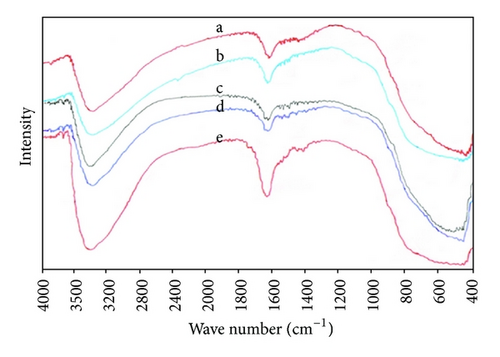
3.1.2. XRD Analysis
| Crystal components | Pt % | Mean crystallite sizes (L)/nm | Crystallite sizes (Ĺ)/nm |
|---|---|---|---|
|
0.000 | 11.487 | 10.132 |
| Pt-TiO2 | 0.250 | 10.799 | 10.021 |
| Pt-TiO2 | 0.500 | 9.355 | 9.503 |
| Pt-TiO2 | 0.750 | 10.221 | 9.589 |
| Pt-TiO2 | 1.000 | 10.475 | 8.262 |
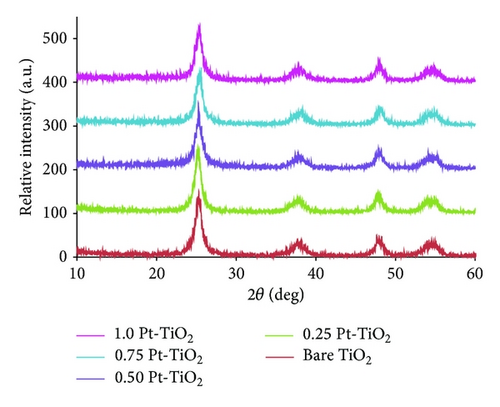
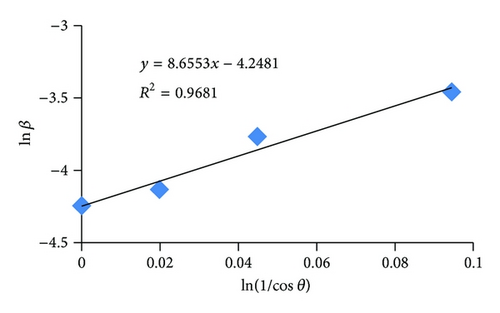
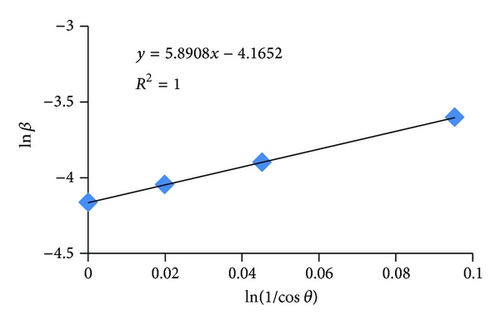
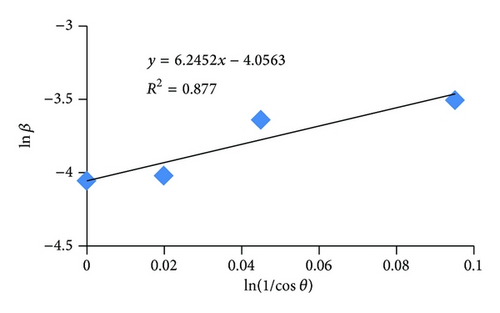
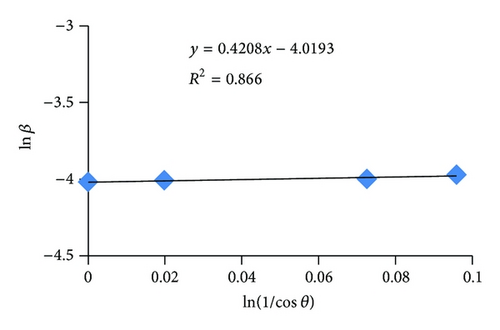
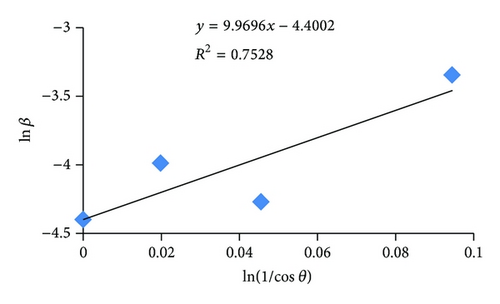
No peak was observed for Pt (0.25 wt%)/TiO2 sample at θ = 46.5°. This result is in good agreement with the previous findings [52]. However, θ = 46.6° which is related to Pt appeared very weak band with Pt (0.5%) loading and increased for Pt (1.0%) as shown in Figure 2. The mean crystallite size of both bare and platinized TiO2 decreased from 11.487 nm to 9.355 nm, respectively. The crystallite size of bare TiO2 was found to be equal to 10.132 nm. This value was decreased with the increasing of Pt content on TiO2. The decreasing of the mean particle size of platinized TiO2 is attributed to the location and incorporation of Pt(IV) with Ti(III) in TiO2 lattice. Moreover, the ionic radius of Pt(IV) (0.63 Å) is relatively smaller than that of Ti(III) (0.67 Å) [53, 54].
3.1.3. AFM Analysis
| Samples | Particle size/nm | *Crystallinity Index | **Crystallinity Index | Average Crystallinity Index |
|---|---|---|---|---|
| TiO2 | 80.940 | 7.046 | 7.988 | 7.517 |
| Pt(0.25)/TiO2 | 63.600 | 5.889 | 6.346 | 6.117 |
| Pt(0.50)/TiO2 | 77.020 | 8.233 | 8.104 | 8.168 |
| Pt(0.75)/TiO2 | 54.890 | 5.370 | 5.724 | 5.547 |
| Pt(1.00)/TiO2 | 73.130 | 6.981 | 8.851 | 7.916 |
- *Crystallinity Index calculated by divided particle size on mean crystallite size and **Crystallinity Index calculated by divided particle size on crystallite size.
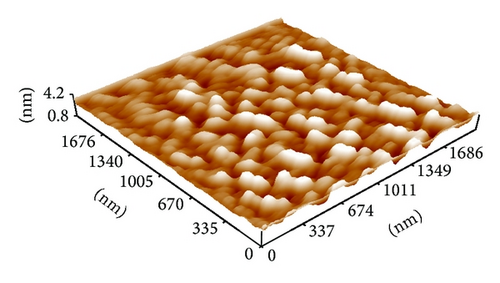
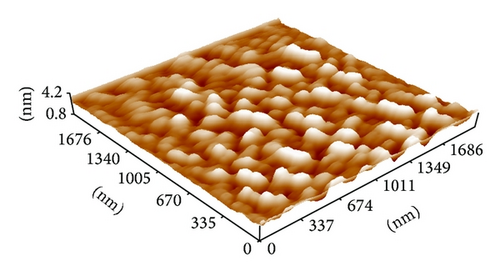
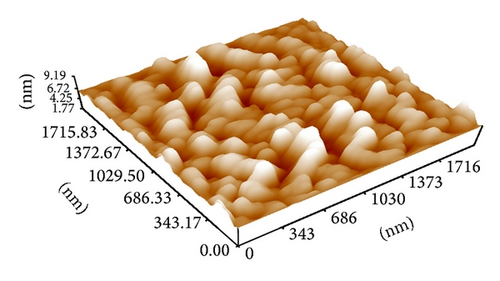
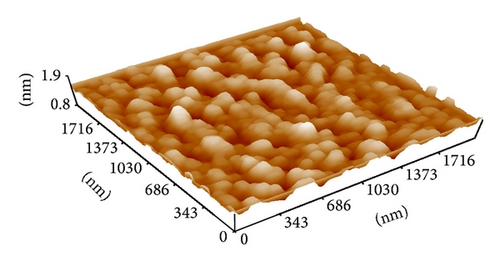
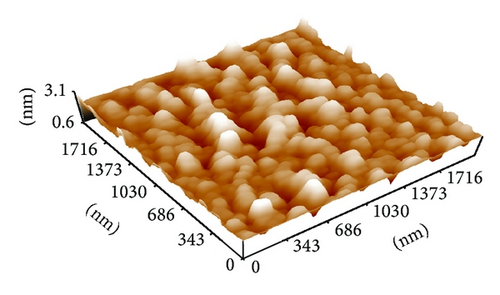
The maximum value of average Crystallinity index for Pt (0.5)/TiO2 is found to be 8.168. That referred to the suppression of the crystal defects number through decreasing the amorphous phase present in TiO2 and overall enhancing the photocatalytic activity of TiO2 [57].
3.1.4. UV-Visible Diffuse Reflectance Spectra
The UV-vis absorbance spectra of the bare TiO2 and platinized TiO2 (0.5% Pt) powders were also measured to confirm the Pt-loading trend and to measure the effect of Pt loading. The results from UV-visible reflectance spectra as plotted in Figure 5 clearly show the shift of absorption edge towards longer wavelength for platinized TiO2. These results indicate that the excitation of metalized TiO2 occurs with the narrowing and red shift of the band gap energy (Eg) peak [58]. These results were subsequently agreed with the increasing of the average Crystallinity Index [57].
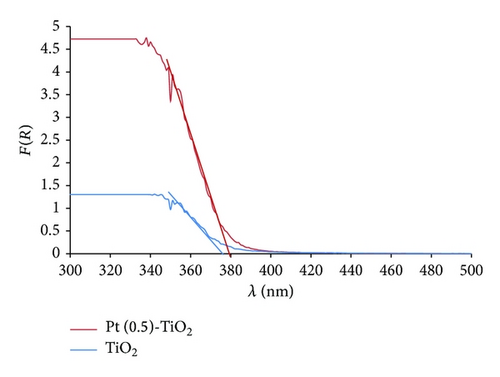
3.2. Effect of the Metal Loading on Photocatalytic Activity of Methanol Solution
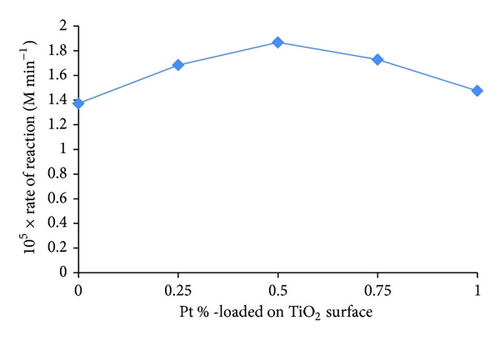
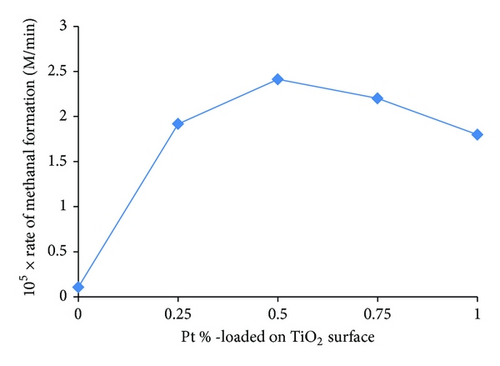
Two mechanisms for the photocatalytic oxidation (in the presence of O2) and photocatalytic dehydrogenation (in the presence of N2) of methanol with Pt (0.5)/TiO2 are suggested as shown in Scheme 1. The scheme shows the differences between the mechanism of photooxidation and photodehydrogenation of methanol on platinized titanium dioxide. The formation of CaCO3 in photooxidation process was indicated by passing the outlet gas in Ca(OH)2 solution. However, no CO2 formation was indicated in photodehydrogenation of methanol.
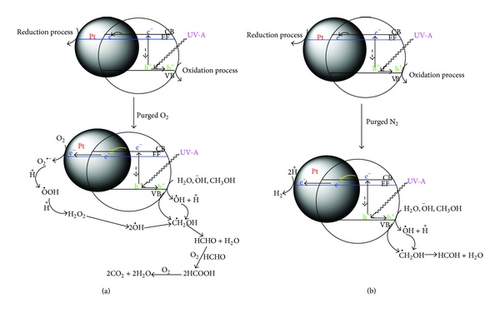
Differences in experimental conditions, such as, experimental equipment, type of photocatalyst, position of band edges of semiconductor compared to redox potential of O2/ and −OH/•OH, and type and concentration of organic pollutant, cause difficulties in the comparison of photocatalytic activity of different materials. Xiang et al. [67] measured the formation rates of hydroxyl free radical for various semiconductor photocatalysts at the same experimental conditions. They discussed the difference of rates formation of hydroxyl free radical on various semiconductors. In another study Xiang et al. [68] showed that hydroxyl radicals are one of active species and indeed participate in photocatalytic reactions. They also found that the photocatalytic activity of Ag-TiO2 exceeds that of P25 by a factor of more than 2. Our results are in good agreement with these findings.
The different yields that are suggested in the two mechanisms are HCOH and H2O in the absence of oxygen (photocatalytic dehydrogenation of methanol) and HCOOH in the presence of oxygen (photocatalytic oxidation of methanol). The pH of the reaction suspension after one hour of irradiation was found 6.93 in dehydrogenation process while it was 4.82 in photooxidation process. This indicates the further oxidation of the formed formaldehyde to formic acid.
4. Conclusions
- (1)
The FT-IR spectra show that the peaks at 3450 cm−1 and 1630 cm−1 related to the surface O–H groups of TiO2 are increased with the increasing of the platinum amount loaded on TiO2 surface. The intense bands at 3621, 3645, and 3696 cm−1 have been observed in all spectra which are characteristics for the tetrahedral coordinated vacancies designated as 4Ti4+–OH. Additionally, a disappearance of two bands at 3765 and 3840 cm−1 attributed to 6Ti3+–OH has been observed as well.
- (2)
The XRD data have been used to calculate the crystallite size of the bare and Pt-loaded TiO2. The values obtained for the crystallite size of the bare TiO2 showed a decrease with the increasing of platinum amount on TiO2.
- (3)
AFM images indicate that the shapes of both bare and platinized TiO2 are spherical.
- (4)
One particle consists of about 9 to 11 crystals.
- (5)
In photoreaction, no reaction occurred with using bare TiO2 under inert gas (N2); however, in the presence of metal, the photoreaction occurred; that is, the existence of the metal substituted the needed for the O2. In the existence of O2 the reaction was carried on to form formic acid as a result of further oxidation of methanol while, in the absence of the O2, dehydrogenation of methanol occurred, and no further photooxidation occurred.
Conflict of Interests
The authors declare that there is no conflict of interests regarding the publication of this paper.




